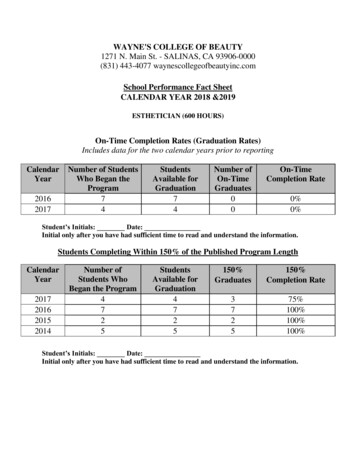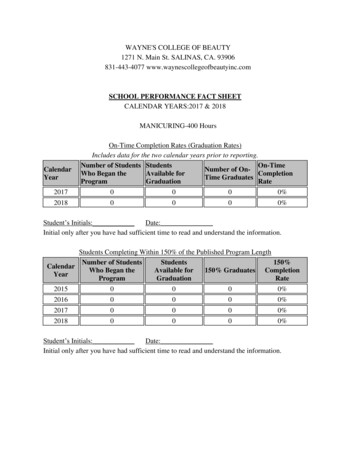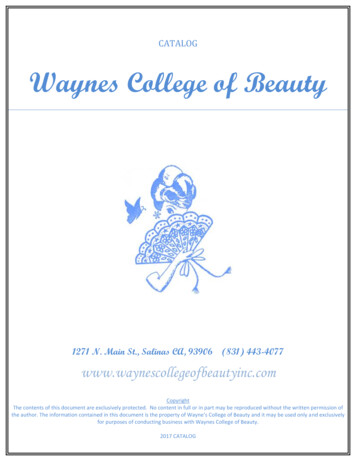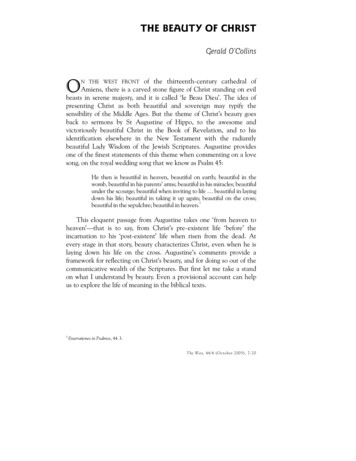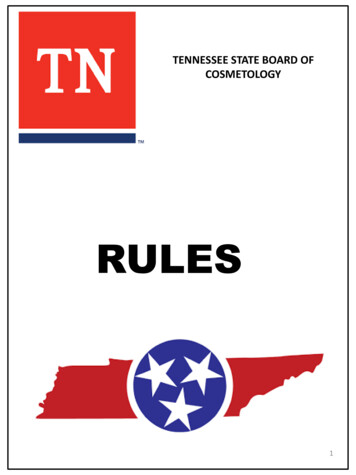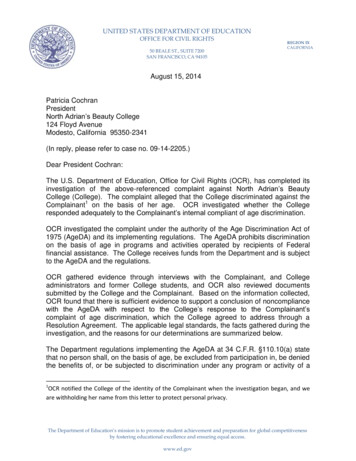
Transcription
UNITED STATES DEPARTMENT OF EDUCATIONOFFICE FOR CIVIL RIGHTS50 BEALE ST., SUITE 7200SAN FRANCISCO, CA 94105REGION IXCALIFORNIAAugust 15, 2014Patricia CochranPresidentNorth Adrian’s Beauty College124 Floyd AvenueModesto, California 95350-2341(In reply, please refer to case no. 09-14-2205.)Dear President Cochran:The U.S. Department of Education, Office for Civil Rights (OCR), has completed itsinvestigation of the above-referenced complaint against North Adrian’s BeautyCollege (College). The complaint alleged that the College discriminated against theComplainant1 on the basis of her age. OCR investigated whether the Collegeresponded adequately to the Complainant’s internal compliant of age discrimination.OCR investigated the complaint under the authority of the Age Discrimination Act of1975 (AgeDA) and its implementing regulations. The AgeDA prohibits discriminationon the basis of age in programs and activities operated by recipients of Federalfinancial assistance. The College receives funds from the Department and is subjectto the AgeDA and the regulations.OCR gathered evidence through interviews with the Complainant, and Collegeadministrators and former College students, and OCR also reviewed documentssubmitted by the College and the Complainant. Based on the information collected,OCR found that there is sufficient evidence to support a conclusion of noncompliancewith the AgeDA with respect to the College’s response to the Complainant’scomplaint of age discrimination, which the College agreed to address through aResolution Agreement. The applicable legal standards, the facts gathered during theinvestigation, and the reasons for our determinations are summarized below.The Department regulations implementing the AgeDA at 34 C.F.R. §110.10(a) statethat no person shall, on the basis of age, be excluded from participation in, be deniedthe benefits of, or be subjected to discrimination under any program or activity of a1OCR notified the College of the identity of the Complainant when the investigation began, and weare withholding her name from this letter to protect personal privacy.The Department of Education’s mission is to promote student achievement and preparation for global competitivenessby fostering educational excellence and ensuring equal access.www.ed.gov
Page 2 – (09-14-2205)recipient of Department funds. Under §110.10(b) a recipient may not treat individualsdifferently on the basis of age with regard to any aspect of the services, benefits,activities, or opportunities it provides. Subsequent sections set forth exceptions tothe rules against age discrimination.Colleges and universities are responsible under the AgeDA and the regulations forproviding students with a nondiscriminatory educational environment. Harassment ofa student based on age can result in the denial or limitation of the student’s ability toparticipate in or receive education benefits, services, or opportunities.Under the AgeDA, once a college has notice of possible age-based harassmentbetween students, it is responsible for determining what occurred and respondingappropriately. The college is not responsible for the actions of a harassing student,but rather for its own discrimination in failing to respond adequately. A college mayviolate the AgeDA and the regulations if: (1) the harassing conduct is sufficientlyserious to deny or limit the student’s ability to participate in or benefit from theeducational program; (2) the college knew or reasonably should have known aboutthe harassment; and (3) the college fails to take appropriate responsive action.These steps are the college’s responsibility whether or not the student who washarassed makes a complaint or otherwise asks the school to take action.OCR evaluates the appropriateness of the responsive action by assessing whether itwas prompt, thorough, and effective. What constitutes a reasonable response toharassment will differ depending upon the circumstances. However, in all cases thecollege must promptly conduct an impartial inquiry designed to reliably determinewhat occurred. The response must be tailored to stop the harassment, eliminate thehostile environment, and remedy the effects of the harassment on the student whowas harassed. The college must also take steps to prevent the harassment fromrecurring, including disciplining the harasser where appropriate.OCR’s investigation showed the following: The Complainant, who was 59 years old when she enrolled in the College’sCosmetology Course on January 17, 2012, was withdrawn from the program onApril 6, 2012. She alleged to OCR that after she filed complaints of agediscrimination against the College, she received no response.2 The Complainant filed complaints with the College that raised her concerns aboutage discrimination on February 26, and March 1, 2012, in which she described,often as “bullying,” age-related comments other students allegedly repeatedlymade to her, and possibly related claims that the same students stole her book2The Complainant filed a complaint in which she raised an allegation of age discrimination on April 17,2012 with California’s Bureau for Private Postsecondary Education, which did not refer the complaintto OCR until January 21, 2014, and had not, as of the date of this letter, conducted its owninvestigation.
Page 3 – (09-14-2205)and keys, and once struck her with their car door in the College parking lot.Examples of the comments the Complainant included in her complaints were, “ Iwas starting to get challenged about the comments that older women think theyknow everything;” and “ [same students] were starting to bully me;” and “ [oneof the same students] made a comment about an older women [sic] gettingroughed up by a male and stating twice ‘she deserved it’;” and “These studentsharassed me, physically attacked me, verbally and mocked me, made fun of myage ;” and “ these [same students] that bullied, harassed me, stole from me ;”and “ who would be in their right mind to assault an elderly women [sic], mock,and verbally abuse;” and “[these other students are young] and hungry forattention so they decide to make someone miserable. I felt so miserable,regretful, so emotional.” The College’s Associate Director responded March 3, 2012 by letter to theComplainant without mentioning age discrimination, but acknowledged the receiptof her “letters,” and informed the Complainant an investigation was underway. The College stated to OCR that while it did not consider the Complainant’scomplaints to raise issues of age discrimination, it did conduct an investigation.The College’s investigation included gathering from some students writteninterview statements that included general questions about intimidation in theclassroom or elsewhere at the College. The complaint interview forms asked noquestions about the specific age-related comments the Complainant alleged inher two written complaints, and the College’s investigation did not otherwiseaddress either the alleged comments, or the other incidents raised by theComplainant, as potential examples of age discrimination. The College’s sole written response to the Complainant’s February 26, and March1, 2012 complaints was its March 20, 2012 letter to the Complainant thatconcluded all of the students wanted to put the matter behind them and move on,except for the Complainant. The College’s letter did not report any investigationof the age-based comments raised by the Complainant, or provide any finding oroutcome related to the issue of alleged age discrimination.The College has a responsibility under the AgeDA and its regulations to respond tocomplaints of age discrimination, including allegations of age harassment by otherstudents, by determining what occurred and responding appropriately. As notedabove, OCR evaluates the appropriateness of the responsive action or process byassessing whether it was prompt, thorough, and effective. The College must ensurethat each allegation of harassment is actually addressed through that process. Inaddition, the College must notify the complainant of the outcome of the complaint.The preponderance of the evidence gathered during the OCR investigation supportsa conclusion that the Complainant raised an allegation of age discriminationregarding the comments she claimed other students made to her about her age, and
Page 4 – (09-14-2205)that the College failed to determine what occurred and to respond appropriately.When the Complainant filed complaints on February 26, and March 1, 2012, sheincluded sufficient detail about the age-related comments and who was allegedlymaking them that the College had notice of possible age-based harassment betweenstudents, and it was responsible for determining what occurred and respondingappropriately. OCR found that the College’s effort to investigate, however, did notinclude any action to examine, address, or resolve the Complainant’s agediscrimination allegation regarding her classmates’ comments. The Complainantnever received notice from the College of the outcome of an investigation of allegedage discrimination because the College never conducted such an investigation.In summary, OCR concluded that the College failed to respond adequately to theComplainant’s internal complaint alleging age discrimination because its investigationdid not address her allegation of age harassment by classmates, and because theCollege did not notify her of the outcome of that process. Ordinarily, under thesecircumstances, OCR could request the College to conduct its own investigation of theComplainant’s age discrimination allegation in order to address this complianceconcern. However, OCR attempted to contact the 26 students who attended classesover two years ago with the Complainant—none of whom are still attending theCollege—and only six responded to requests for interviews. None of the six toldOCR that they either heard the alleged comments or saw any of the allegedincidents. Based on its own investigation of the underlying age discriminationallegations, including the attempts to contact the relevant witnesses and theresponses it received, OCR was unable to establish by a preponderance of theevidence that age discrimination took place. Therefore, OCR is not asking theCollege to re-investigate the age discrimination allegations.In addition to the requirements above, the AgeDA regulations also establishprocedural requirements that are important for the prevention and correction of agediscrimination, including harassment. These requirements include issuance of noticethat age discrimination is prohibited (34 C.F.R. §110.25(b)) and adoption andpublication of grievance procedures providing for the prompt and equitable resolutionof complaints of age discrimination (34 C.F.R. §110.25(c)). The regulations alsorequire that colleges designate at least one employee to coordinate compliance withthe regulations, including coordination of investigations of complaints allegingnoncompliance (34 C.F.R. §110.25(a)). The notification required by 34 C.F.R.§110.25(b) must also identify the responsible employee by name or title, address,and telephone number.OCR examines a number of factors in evaluating whether a college’s grievanceprocedures are prompt and equitable, including whether the procedures provide forthe following: notice to students and employees of the procedures, including wherecomplaints may be filed (and then again, one notice within the proceduresthemselves that say where to file a complaint), that is easily understood, easilylocated, and widely distributed; application of the procedures to complaints alleging
Page 5 – (09-14-2205)discrimination or harassment carried out by employees, other students, and thirdparties; adequate, reliable, and impartial investigation, including an equal opportunityto present witnesses and relevant evidence; designated and reasonably prompttimeframes for major stages of the grievance process, as well as the process forextending timelines; written notice to the parties of the outcome of the complaint; andan assurance that the college will take steps to prevent recurrence of harassmentand to correct its discriminatory effects on the complainant and others, if appropriate.OCR’s investigation showed the following: The College’s statement of nondiscrimination in its Catalog and Consumer Guidestates that the College does not discrimination on the basis of age (and otherbases). The statement does not contain the responsible employee’s name or title,address, and telephone number. The College stated to OCR that in March, 2010, it designated two Student AffairsRepresentatives as its employees responsible for coordinating its efforts tocomply with and carry out its responsibilities under the AgeDA. The College’s example of notice it provided to OCR regarding its responsibleemployees was a slide from a student orientation PowerPoint presentation. Theslide contains the responsible employees’ names and titles, and telephonenumbers, but not their address. The College’s grievance procedures, Grievance Procedure/Internal ComplaintProcedure, refer to students who may “have a problem with an individual,” but donot provide students notice that the procedures are to be used for complaints ofdiscrimination. The Grievance/Internal Complaint Procedure does not includeinformation about where complaints may be filed. The Grievance/Internal Complaint Procedure asks students, as an initial step, todiscuss “problems” with the individuals involved to try to resolve concerns, andincludes an additional step that involves contact with the College’s Student AffairsRepresentatives prior the concerns being considered a “serious grievance.” Thisstep omits an explanation that it is voluntary, and the terms problems and seriousgrievance are not defined the Procedure. At the stage described in the Procedure as the “serious grievance” stage, theGrievance/Internal Complaint Procedure provide that a written grievance will beevaluated by the Student Affairs Representative, but this evaluation does notexplicitly describe any steps that might provide an adequate, reliable, andimpartial investigation, including an equal opportunity to present witnesses andrelevant evidence. No other step in the Grievance/Internal Complaint Procedureprovides for any investigation.
Page 6 – (09-14-2205) Regarding timeframes for major stages of the grievance process, theGrievance/Internal Complaint Procedure contains no process for extendingtimelines, and provides as a time period for filing a grievance five business daysfrom the date of the incident. The Grievance/Internal Complaint Procedure provides that a grievant will receivea written response, without a prior investigation, from the Student AffairsRepresentative. Between January 1, 2010 and May 8, 2014, the College received two complaintsof discrimination on the basis of age, sex, race, color, national origin, and/ordisability. The College’s Procedure refers students with remaining unsatisfactorilyanswered questions after using its Grievance/Internal Complaint Procedure to theDepartment of Consumer Affairs in Sacramento, or to the Bureau for PrivatePostsecondary Education in Sacramento.OCR found that the College’s notice of nondiscrimination statement is inadequatebecause all of the required information about the College’s responsible employees isnot included, and therefore no notice by the College has been adequately provided.Also, OCR found that even if students routinely receive a copy of the orientationPowerPoint slide, there was no other evidence that the College had providedstudents the notice required by the regulations at 34 C.F.R. §110.25(b), in acontinuing manner.While the College’s Grievance/Internal Complaint Procedure includes a step thatrequires the College to provide a grievant with written notice of the outcome of agrievance, OCR found that that the Procedure does not contain the other requiredelements of a prompt and equitable grievance procedures, and thus OCR concludedthe College’s procedure fails to meet the standards for prompt and equitablegrievance procedures in the AgeDA regulations.The College agreed to address these areas of non-compliance through signing aResolution Agreement, a copy of which is attached, that is limited to issues arisingunder the AgeDA. The Resolution Agreement requires the College to update itsnondiscrimination statement with the information required by the AgeDA regulation,and to provide OCR evidence it has provided its beneficiaries notice in a continuingmanner of its nondiscrimination statement. OCR has also provided to the College atechnical assistance fact sheet developed by OCR that was designed to assisteducation institutions in establishing a notice of nondiscrimination that meets therequirements of all of the applicable regulations. The College agreed to revise itsgrievance procedures, that OCR only reviewed for compliance pursuant to theAgeDA, to ensure that they provide for the prompt and equitable resolution ofcomplaints of age discrimination, including age harassment, and to publish anddistribute the updated grievance procedure to its employees and students. The
Page 7 – (09-14-2205)College also agreed to provide training to all administrators, faculty, and other staffwho are involved in the resolution of complaints of age discrimination.Based on the commitments made in the attached Resolution Agreement, OCR isclosing the investigation of this complaint as of the date of this letter. OCR willmonitor the College’s implementation of the Resolution Agreement. This concludesOCR’s investigation of the complaint and should not be interpreted to address theCollege’s compliance with any other regulatory provision or to address any issuesother than those addressed in this letter. OCR is informing the Complainant of thecomplaint resolution by concurrent letter.The Complainant has the right, pursuant to the regulation at 34 C.F.R. § 110.39implementing the Age Act, to file a civil action for injunctive relief in federal courtfollowing the exhaustion of administrative remedies. Administrative remedies areexhausted if: (1) 180 days have elapsed since the complainant filed the complaintwith OCR, and OCR has made no finding, or (2) OCR issues any finding in favor ofthe recipient. A civil action can be brought only in a United States district court forthe district in which the recipient is found or transacts business. A complainantprevailing in a civil action has the right to be awarded the costs of the action,including reasonable attorney’s fees, but these costs must be demanded in thecomplaint filed with the court. Before commencing the action, the complainant shallgive 30 days notice by registered mail to the Secretary of the Department ofEducation, the Secretary of the Department of Health and Human Services, theAttorney General of the United States, and the recipient. The notice shall state theviolation of the Age Act, the relief requested, the court in which the action will bebrought, and whether or not attorney’s fees are demanded in the event thecomplainant prevails. The complainant may not bring an action if the same allegedviolation of the Age Act by the same recipient is the subject of a pending action inany court of the United States.This letter sets forth OCR's determination in an individual OCR case. This letter isnot a formal statement of OCR policy and should not be relied upon, cited, orconstrued as such. OCR’s formal policy statements are approved by a dulyauthorized OCR official and made available to the public.Please be advised that the College may not harass, coerce, intimidate, ordiscriminate against any individual because he or she has filed a complaint orparticipated in the complaint resolution process. If this happens, the individual mayfile a complaint with OCR alleging such treatment.Under the Freedom of Information Act, it may be necessary to release this documentand related correspondence and records upon request. I
North Adrian’s Beauty College 124 Floyd Avenue Modesto, California 95350-2341 (In reply, please refer to case no. 09-14-2205.) Dear President Cochran: The U.S. Department of Education, Office for Civil Rights (OCR), has completed its investigation of the above-referenced c


